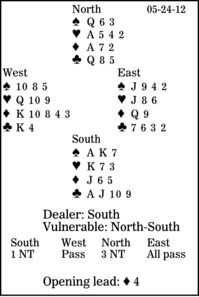Bridge column, May 24: The 'automatic play' that may be fatal

There are plays that look automatic at the bridge table. And more often than not, they will be correct. What looks automatic in this three-no-trump contract after West leads his fourth-highest diamond? How is it fatal?
It is normally best not to use Stayman with 4-3-3-3 distribution. If a major-suit fit isn't found, the defenders have been given free information. And if opener is also 4-3-3-3, three no-trump is probably better than game in the major.
South starts with seven top tricks: three spades, two hearts, one diamond and one club. At least two more tricks are available in clubs. If that finesse is winning, the contract is in no danger. But what if the finesse is losing?
The "automatic" play is low from the dummy at trick one. But here East wins with the queen and returns his second diamond. Then, when West gets in with the club king, he runs the diamonds.
If diamonds are 4-3, there is no problem. But if West has five diamonds, what is East's holding?
He will probably have king- or queen-doubleton. (It is possible that he has 10-doubleton, but not as likely.) Given that, declarer's correct play is immediately to call for dummy's diamond ace. Then he takes the club finesse. With the diamond suit blocked, the door opens to the contract.
** ** **
COPYRIGHT: 2012, UNITED FEATURE SYNDICATE
DISTRIBUTED BY UNIVERSAL UCLICK FOR UFS

